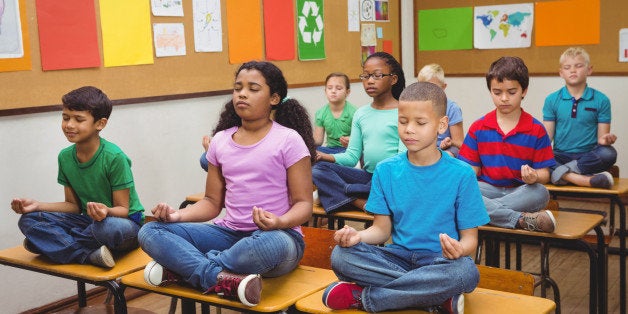
Co-authored by Elisa Hartwig
Your four-year-old's preschool has recently decided to bring in a yoga and mindfulness teacher for a special daily session. Excitedly, your child comes home to tell you about something new called belly breathing, and how she has been taught to carefully listen to the sound of a chimed bell. She then proceeds to show you that she can contort into animal poses and a "tree," mentioning that these exercises can help her with balance and imagination. Perhaps you start to witness fewer meltdowns and volatile sibling battles, better resilience when waiting in check-out lines, and more equanimity in the face of brussel sprouts...
Is this the dream child you've tried negotiating for with your higher power throughout every manic temper tantrum? Not so fast.
Mindfulness, as often described to young children, is the practice of paying attention in a very special way. It teaches children to build an awareness of oneself, others, and one's surroundings. Here's a brief history on the topic: the mindfulness that you may hear about coming from your young one is most likely rooted in Mindfulness-Based Stress Reduction (MBSR), a popular, scientifically-researched, secularized approach to Buddhist practices constructed by Jon Kabat-Zinn in the late 1970s. As a professor of medicine, Kabat-Zinn developed MBSR training to help his patients cope with psychological and psychosomatic problems. So what is it doing in your child's preschool classroom? Well, studies report that practicing mindfulness may increase executive functioning and self-regulation skills, which is basically the mental processes that allow us to focus, plan, remember, and multi-task. Given that mindfulness is a "trainable" skill which improves the self-regulation and control most often associated with "school readiness," teachers and parents are praising its ideology. However, despite discernible benefits, mindfulness practice in the early years may also cause some concern.
First off, take a moment to think about the underlying agenda of practicing mindfulness in schools: increasing "normalized" behavior, fewer emotional outbursts, teaching children to accept the frustration and hardships they endure, instead of taking a critical approach to understanding them. Essentially, mindfulness is being removed from its holistic roots in order to make sure your child behaves "normally" as the academic year progresses and decrease any stress caused by the increasing push-down of academic expectations and high-stakes assessment into the early years.
To muddy the waters even more, several schools are standardizing this approach to well-being and several mindfulness curriculums are indeed measuring and evaluating your child's ability to remain "zen." There are at least nine different questionnaires that claim to define and measure mindfulness, but no standard of reference exists which can be used to evaluate such questionnaires. Even Kabat-Zinn admitted that mindfulness cannot be accurately measured using survey based instruments.
Standardizing and measuring mindfulness coincides with the problematic notion of separating mindfulness from its Buddhist roots. Hence, mindfulness as "technical spirituality" becomes a mechanism for improving productivity, efficiency, and gaining tangible results -- aspects that are not only far removed from the Buddhist concept of mindfulness and the principle of egoless dedication to all "sentient beings," but work in opposition to it. Buddhist scholar Luiz Gomez claims that this form of decontextualization holds orientalist bias and an unavowed colonial stance. Not only is mindfulness difficult to measure, but what is being measured may not be mindfulness at all. Presenting, standardizing, and measuring a technological form of the practice may become just another commodified trend of a gentrified version of a long-established Asian tradition.
Another problematic aspect of this form of mindfulness in the early years is the attention given to preparing students to comply with the behavioral demands seen in most elementary institutions, including demonstrating appropriate emotional responses and maintaining positive relationships with teachers and other school authorities. The emphasis on sublimating strong emotions such as anger could send unintended messages about not speaking up in the face of injustice, which has serious ramifications for dissuading children's later participation in social activism. Actually, teaching mindfulness that lacks a critical lens may perpetuate and promote what Ronald Purser and Joseph Milillo call "institutional blindness", which helps to maintain the status quo rather than lead transformative change of power-structures. Such learning environments may encourage children to become peaceful and passive in their acceptance of hardships, rather than questioning, or holding an oppositional stance to inequities of social class, race, or gender. So, when teaching mindfulness becomes a vehicle toward academic improvement and encouraging "normalized" behavior, we run the cost of neglecting an awareness of the oppression that many people in our world currently endure.
So, you may wonder why a five-year-old needs to be an agent of change. What happened to playdough and puzzles? Well, recognition of injustices and social activism is indeed developmentally appropriate, and we need to equip our children with both insight and problem-solving, equanimity as well as social responsibility, and the commitment and courage to advocate for a better society.
As early childhood educators with our own mindfulness practices, we are both inclined to explore the positive aspects of bringing these practices into the classroom. However, we encourage those who do so to consider how they may be using these strategies for well-being as a way to inadvertently sedate children rather than empower them.
